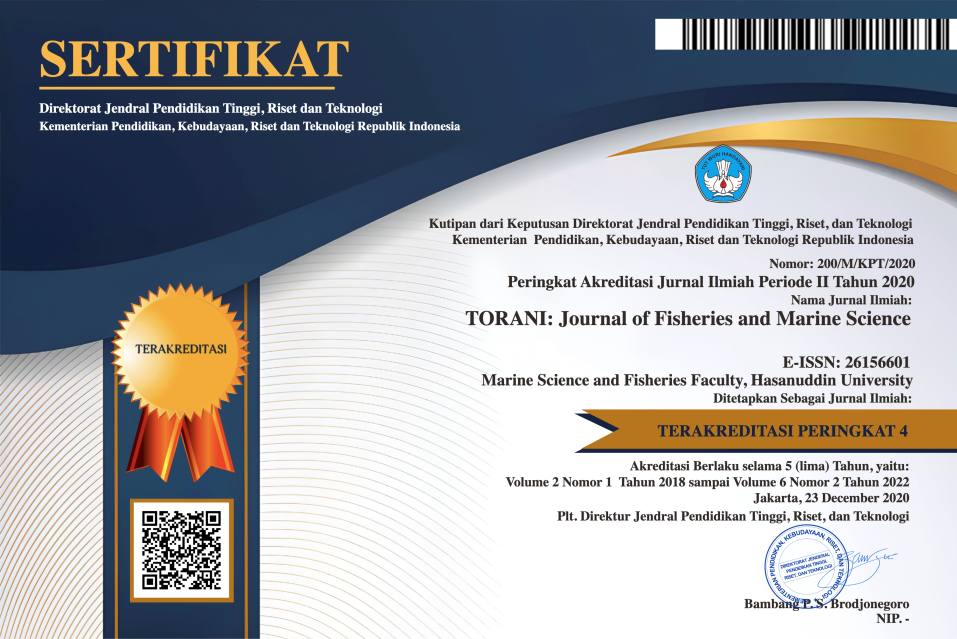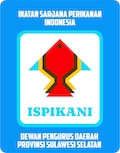Effectivity of mulberry leaf extract on stimulating ekdisteroid hemolimph content and molting of mud crab (Scylla olivacea)
DOI:
https://doi.org/10.35911/torani.v2i1.5857Abstract
This study aims to study the performance of phytoecdisteroids from mulberry leaves in molting stimulating of mangrove crabs. The research was carried out at the Research and Development Center for Aquaculture at the Faculty of Marine Sciences and Fisheries at Hasanuddin University, located in Bojo Village, Mallusetasi District, Barru Regency, South Sulawesi Province. Mangrove crabs (Scylla olivacea) weighing 45-55 g and carapace widths 60-65 mm were used as test animals. There were five doses of mulberry leaf extract applied through feed, namely: A) 1.1 mg / g feed, B) 1.9 mg / g feed, C) 2.7 mg / g feed, D) 3.5 mg / g feed. Crabs were kept individually in plastic boxes that are floated above the surface of the pond. During rearing, crabs are fed 3% dry fish per day which has been enriched with mulberry leaf extract. The parameters observed were ecdysteroid compounds contained in mulberry leaf extract, ecdysteroid content in hemolymph before and after application of mulberry leaf extract, and molting percentage. Identification of the ekdisteroid compounds contained in mulberry leaf extract was carried out using Thin Layer Chromatography (TLC) and Measurement of the content of ecdysteroids in crab hemolymh was carried out using Ultra Fast Liquid Chromatography (UFLC). The results showed that the 3.5 mg dose of mulberry leaf extract / g feed gave the highest increase in ecdysteroid hemolymph, which was approximately 1760 ekdisteroid per mL hemolimph, while the dose of 1.1 mg / g feed only provided an increase of 100 ng ekdisteroid per mL hemolymph. The higher the dose of mulberry leaf extract in the feed, the higher the increase in the concentration of hemolymph ecdysteroids, but the high concentration of ecdystoid in the hemolymph does not guarantee molting. The optimal dose of mulberry leaf extract in the feed stimulating molting was 2.4 mg / g of feed.
Keywords: mulberry, phytoecdysteroid, molting, crab, aquacultureReferences
Bathori, M., Pongracz, Z., (2005), Phytoecdysteroids- from isolation to their effects on humans. Current Medicinal Chemistry, 12: 153-172
Chang, ES., Mykles, DL., (2011), Regulation of crustacean molting: A review and our perspectives. General and Comparative Endocrinology, 172:323-330
Dinan, L., (2001), Phytoecdysteroids: biological aspects. Phytochemistry, 57:325-339
Fujaya, Y., Trijuno, DD., (2007), Haemolymph ecdysteroid profile of mud crab during molt and reproductive cycles. Torani 17(5): 415-421.
Fujaya, Y., S Aslamyah, L Fudjaja., N Alam. (2012). Budidaya dan Bisnis Kepiting Lunak. Brillian Internasional. Surabaya
Fujaya, Y., (2011). Pertumbuhan dan Molting Kepiting Bakau yang Diberi Dosis Vitomolt Berbeda. Jurnal Akuakultur Indonesia, 10(1), 24-28.
Hartnoll, RG., (1983), Strategies of Crustacean Growth. Dalam Papers from the Conference on the Biology and Evolution of Crustacea. James K. Lowry (editor). Trustees of the Australian Museum. Sydney, Australia
Huberman. (2000). Shrimp endocrinology: a review. Aquaculture, 191, 191-208.
Klein R., (2004), Phytoecdysteroids. Journal of the American Herbalist Guild, 18-28.
Kuballa, A., Elizur, A., (2007), Novel molecular approach to study moulting in crustaceans. Bull. Fish. Res. Agen. 20:53-57
Lafont R., Dinan, L., (2003), Practical uses for ecdysteroids in mammals including humans: and update. Journal of insect science, 3(7): 1-21.
Luppi, TA., Spivak, ED., Bas, CC., Anger, K., (2004), Molt and growth of an estuarine crab, Chasmagnathus granulates (Brachyura:Varunidae), in Mar Chiquita coastal lagoon, Argentina. J. Appl. Ichthyol, 20:333-344
Meyer, JR., (2007). Morphogenesis. Department of entomologi NC State University. Retrieved from www.morphogenesis .htm. DL 27 September 2007.
Miller, AEM., Heyland, A., (2010), Endocrine interaction between plants and animals: implications of exogenous hormone sources for the evolution of hormone signaling. General and Comparative Endocrinology, 166:455-461.
Mykles, DL., (2011), Ecdysteroid metabolism in crustaceans. Journal of Steroid Biochemistry and Molecular Biology, 127:196-203
Thompton, JD., Tamone, SL., Atkinson, S., (2006), Circulating ecdysteroid concentration in Alaskan Dungesess crab (Cancer magister). Journal of crustacean biology, 26(2), 176-181
Zimecki, M., (2006), The lunar cycle: effects on human and animal behavior and physiology. Postepy Hig Med Dosw (online), 60:1-7.















